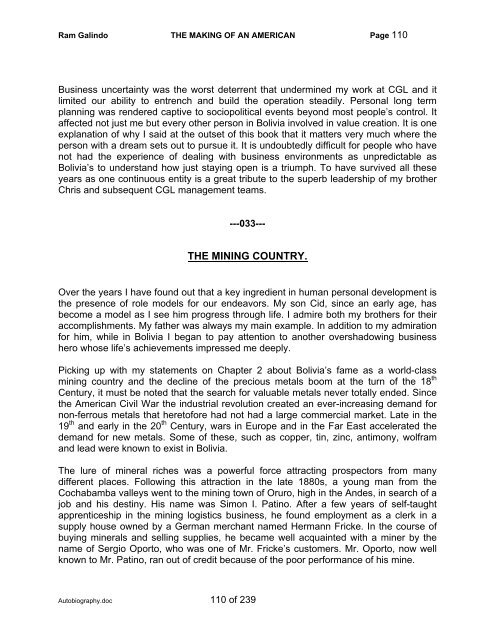Autobiography - The Galindo Group
Autobiography - The Galindo Group
Autobiography - The Galindo Group
You also want an ePaper? Increase the reach of your titles
YUMPU automatically turns print PDFs into web optimized ePapers that Google loves.
Ram <strong>Galindo</strong> THE MAKING OF AN AMERICAN Page 110<br />
Business uncertainty was the worst deterrent that undermined my work at CGL and it<br />
limited our ability to entrench and build the operation steadily. Personal long term<br />
planning was rendered captive to sociopolitical events beyond most people’s control. It<br />
affected not just me but every other person in Bolivia involved in value creation. It is one<br />
explanation of why I said at the outset of this book that it matters very much where the<br />
person with a dream sets out to pursue it. It is undoubtedly difficult for people who have<br />
not had the experience of dealing with business environments as unpredictable as<br />
Bolivia’s to understand how just staying open is a triumph. To have survived all these<br />
years as one continuous entity is a great tribute to the superb leadership of my brother<br />
Chris and subsequent CGL management teams.<br />
---033---<br />
THE MINING COUNTRY.<br />
Over the years I have found out that a key ingredient in human personal development is<br />
the presence of role models for our endeavors. My son Cid, since an early age, has<br />
become a model as I see him progress through life. I admire both my brothers for their<br />
accomplishments. My father was always my main example. In addition to my admiration<br />
for him, while in Bolivia I began to pay attention to another overshadowing business<br />
hero whose life’s achievements impressed me deeply.<br />
Picking up with my statements on Chapter 2 about Bolivia’s fame as a world-class<br />
mining country and the decline of the precious metals boom at the turn of the 18 th<br />
Century, it must be noted that the search for valuable metals never totally ended. Since<br />
the American Civil War the industrial revolution created an ever-increasing demand for<br />
non-ferrous metals that heretofore had not had a large commercial market. Late in the<br />
19 th and early in the 20 th Century, wars in Europe and in the Far East accelerated the<br />
demand for new metals. Some of these, such as copper, tin, zinc, antimony, wolfram<br />
and lead were known to exist in Bolivia.<br />
<strong>The</strong> lure of mineral riches was a powerful force attracting prospectors from many<br />
different places. Following this attraction in the late 1880s, a young man from the<br />
Cochabamba valleys went to the mining town of Oruro, high in the Andes, in search of a<br />
job and his destiny. His name was Simon I. Patino. After a few years of self-taught<br />
apprenticeship in the mining logistics business, he found employment as a clerk in a<br />
supply house owned by a German merchant named Hermann Fricke. In the course of<br />
buying minerals and selling supplies, he became well acquainted with a miner by the<br />
name of Sergio Oporto, who was one of Mr. Fricke’s customers. Mr. Oporto, now well<br />
known to Mr. Patino, ran out of credit because of the poor performance of his mine.<br />
<strong>Autobiography</strong>.doc 110 of 239


